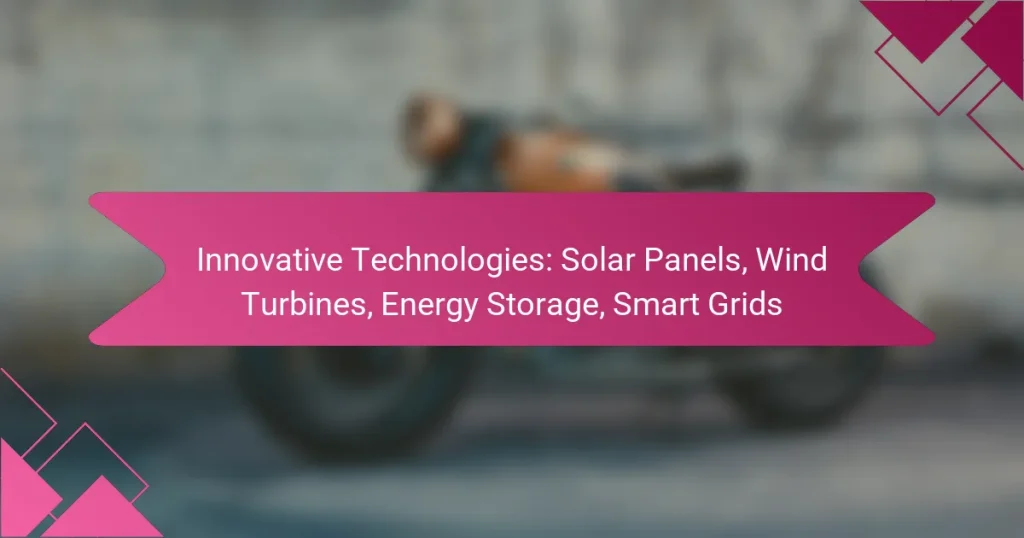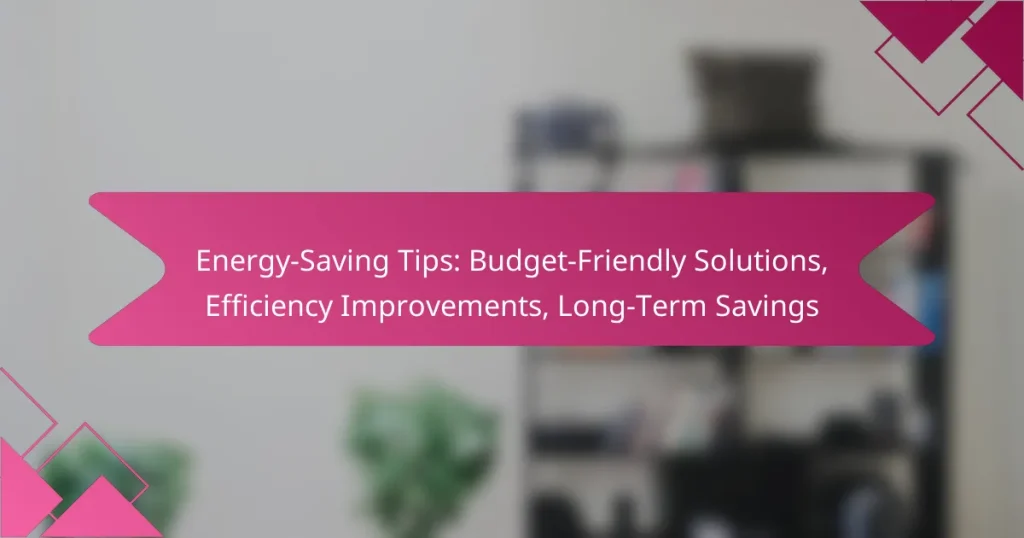Sustainable energy solutions are vital for promoting environmental sustainability and reducing reliance on fossil fuels. In the United States, options such as solar, wind, geothermal, hydropower, and biomass energy provide renewable alternatives that significantly lower carbon emissions. By embracing these technologies, communities can enhance energy independence while contributing to a cleaner, healthier planet.
Government Incentives: Tax Credits, Rebates, Grants, Financing Options
Energy-Saving Tips: Budget-Friendly Solutions, Efficiency Improvements, Long-Term Savings
Energy Consumption Reduction: Home Insulation, Efficient Appliances, Smart Thermostats
What Are the Best Sustainable Energy Solutions in the US?
The best sustainable energy solutions in the US include solar, wind, geothermal, hydropower, and biomass energy. These options provide renewable alternatives to fossil fuels, helping to reduce carbon emissions and promote environmental sustainability.
Solar Energy Systems
Solar energy systems harness sunlight to generate electricity or heat. They typically consist of photovoltaic (PV) panels or solar thermal systems, which can be installed on rooftops or in large solar farms. Homeowners can benefit from tax credits and incentives, making solar a cost-effective option in many regions.
When considering solar energy, evaluate your location’s sunlight exposure and available incentives. Systems can range from small residential setups to large commercial installations, with costs varying widely based on size and technology.
Wind Energy Solutions
Wind energy solutions utilize wind turbines to convert wind kinetic energy into electricity. These systems can be deployed onshore or offshore, with larger turbines typically found in wind farms. Wind energy is one of the fastest-growing renewable sources in the US, providing significant amounts of clean power.
For effective wind energy generation, consider average wind speeds in your area. Small residential wind turbines can be a viable option for homes in windy regions, while larger installations may require substantial investment and land access.
Geothermal Heating and Cooling
Geothermal heating and cooling systems use the Earth’s stable underground temperature to regulate indoor climates. These systems involve the installation of ground loops that exchange heat with the Earth, providing efficient heating in winter and cooling in summer. Geothermal systems can significantly reduce energy bills over time.
When evaluating geothermal options, assess the geological conditions of your property and the potential for installation. While upfront costs can be high, long-term savings and environmental benefits often justify the investment.
Hydropower Options
Hydropower options generate electricity by using flowing water to turn turbines. This renewable energy source can be harnessed from large dams or small-scale run-of-river projects. Hydropower is a reliable and consistent energy source, contributing to a significant portion of the US’s renewable energy output.
Consider the environmental impact and regulatory requirements when exploring hydropower. Small-scale systems may be more feasible for individual use, while larger projects often require extensive permits and environmental assessments.
Biomass Energy Sources
Biomass energy sources convert organic materials, such as plant and animal waste, into usable energy. This can be achieved through direct combustion, gasification, or anaerobic digestion. Biomass is considered renewable as long as the materials are sourced sustainably.
When utilizing biomass energy, ensure that the feedstock is locally sourced to minimize transportation emissions. Biomass systems can vary in scale from small residential units to large industrial plants, with considerations for efficiency and emissions control being crucial for sustainable operation.
How Do Solar Energy Systems Work?
Solar energy systems convert sunlight into usable energy, primarily through photovoltaic (PV) cells or solar thermal systems. These technologies harness solar radiation to generate electricity or heat, making them essential for sustainable living.
Photovoltaic Technology
Photovoltaic technology uses solar panels composed of many solar cells to convert sunlight directly into electricity. When sunlight hits the cells, it excites electrons, creating an electric current. This process is efficient and can be used in various applications, from small residential setups to large solar farms.
When considering photovoltaic systems, factors like panel efficiency, orientation, and shading are crucial. For optimal performance, panels should ideally face south and be installed at an angle that maximizes sun exposure throughout the year. In many regions, solar panels can reduce electricity bills by 50% or more, depending on local energy prices.
Solar Thermal Systems
Solar thermal systems capture sunlight to produce heat, which can be used for water heating or space heating. These systems typically use solar collectors that absorb sunlight and transfer the heat to a fluid, which is then used to heat water or air in a building.
When installing solar thermal systems, consider the size of the system relative to your hot water needs. A typical residential solar water heater can meet 50-80% of hot water needs, depending on climate and usage patterns. Additionally, local regulations may offer incentives for installation, making it a financially attractive option for homeowners.
What Are the Benefits of Wind Energy?
Wind energy offers numerous advantages, including reduced electricity costs and a significant decrease in greenhouse gas emissions. By harnessing the power of wind, communities can create sustainable energy solutions that contribute to a cleaner environment and energy independence.
Cost-Effectiveness
Wind energy is increasingly recognized for its cost-effectiveness. The price of wind power has declined significantly over the past decade, making it one of the most affordable sources of electricity in many regions. In some areas, the cost of wind energy is now competitive with or lower than fossil fuels.
Investing in wind energy can lead to long-term savings on electricity bills. Many wind farms have operational costs that are lower than traditional power plants, which can translate to lower prices for consumers. Additionally, government incentives and tax credits can further enhance the financial viability of wind projects.
Environmental Impact
The environmental benefits of wind energy are substantial. Wind power generation produces no direct emissions, which helps to mitigate air pollution and combat climate change. By replacing fossil fuels with wind energy, communities can significantly reduce their carbon footprint.
Moreover, wind farms occupy less land than traditional power plants, and they can coexist with agricultural activities. This dual-use approach allows for sustainable land management while generating clean energy. However, it is essential to consider the potential impact on local wildlife and take measures to minimize any adverse effects.
How to Choose the Right Sustainable Energy Solution?
Choosing the right sustainable energy solution involves assessing your energy needs, considering your location, and evaluating your budget along with available incentives. Each factor plays a crucial role in determining the most effective and efficient energy source for your situation.
Energy Needs Assessment
Start by evaluating your current energy consumption patterns. Determine how much energy you use on a daily and monthly basis, considering factors like appliances, heating, and cooling systems. This assessment helps identify the capacity required from a sustainable energy solution.
Consider future energy needs as well, such as potential increases from home expansions or the addition of electric vehicles. A thorough understanding of your energy requirements will guide you in selecting the appropriate system, whether it’s solar panels, wind turbines, or geothermal heating.
Location Considerations
Your geographical location significantly impacts the effectiveness of different sustainable energy solutions. For instance, solar energy is most effective in sunny regions, while wind energy thrives in areas with consistent wind patterns. Analyze local climate conditions and natural resources to determine the best fit.
Additionally, consider local regulations and zoning laws that may affect the installation of certain energy systems. Research any community incentives or restrictions that could influence your choice, ensuring compliance with local standards.
Budget and Incentives
Establishing a budget is essential when selecting a sustainable energy solution. Costs can vary widely based on the technology, installation, and maintenance. Research the initial investment required for systems like solar panels or wind turbines, and factor in long-term savings on energy bills.
Look for government incentives, tax credits, or rebates available in your area that can offset installation costs. Many regions offer financial support for adopting renewable energy solutions, making them more accessible. Understanding these financial aspects can help you make a more informed decision while maximizing your investment.
What Are the Challenges of Implementing Sustainable Energy?
Implementing sustainable energy solutions faces several challenges, including financial, regulatory, and technological barriers. These obstacles can hinder the transition to renewable energy sources and impact the overall effectiveness of sustainability efforts.
Initial Investment Costs
One of the primary challenges in adopting sustainable energy is the initial investment required. Technologies such as solar panels or wind turbines can have high upfront costs, often ranging from several thousand to tens of thousands of dollars, depending on the scale of the installation.
While these investments may lead to long-term savings on energy bills, the initial financial burden can deter individuals and businesses. To mitigate this, consider financing options, tax incentives, or grants available in your region that can help offset these costs.
Regulatory Hurdles
Regulatory hurdles can significantly impact the implementation of sustainable energy solutions. Different regions may have varying laws and regulations that govern renewable energy installations, which can complicate the approval process.
For example, some areas may require extensive permits or compliance with specific standards before installation can begin. It is crucial to research local regulations and engage with local authorities early in the process to ensure compliance and avoid delays.
What Are the Future Trends in Sustainable Energy?
Future trends in sustainable energy focus on increasing efficiency, reducing costs, and integrating advanced technologies. Key developments include energy storage improvements, smart grid innovations, and supportive policy changes that encourage renewable energy adoption.
Advancements in Energy Storage
Energy storage technologies are evolving rapidly, enabling more efficient use of renewable resources. Innovations such as lithium-ion batteries and emerging solid-state batteries are enhancing capacity and reducing costs, making them more accessible for residential and commercial use.
For example, homeowners can now invest in battery systems that store solar energy for use during peak hours, reducing reliance on the grid. These systems can provide savings of up to 30% on energy bills, depending on local energy prices and incentives.
Smart Grid Technologies
Smart grid technologies enhance the efficiency and reliability of electricity distribution. By utilizing digital communication tools, these systems allow for real-time monitoring and management of energy flow, which optimizes energy use and integrates renewable sources more effectively.
Consumers can benefit from smart meters that provide detailed usage data, enabling them to adjust consumption patterns and save on costs. Additionally, utilities can better manage demand and reduce outages, leading to a more resilient energy infrastructure.
Policy Changes and Incentives
Government policies and incentives play a crucial role in promoting sustainable energy solutions. Many countries are implementing tax credits, rebates, and grants to encourage the adoption of renewable technologies, making them more financially viable for individuals and businesses.
For instance, in the United States, the federal solar tax credit allows homeowners to deduct a significant percentage of solar installation costs from their taxes. Staying informed about local incentives can help maximize savings when investing in sustainable energy solutions.



